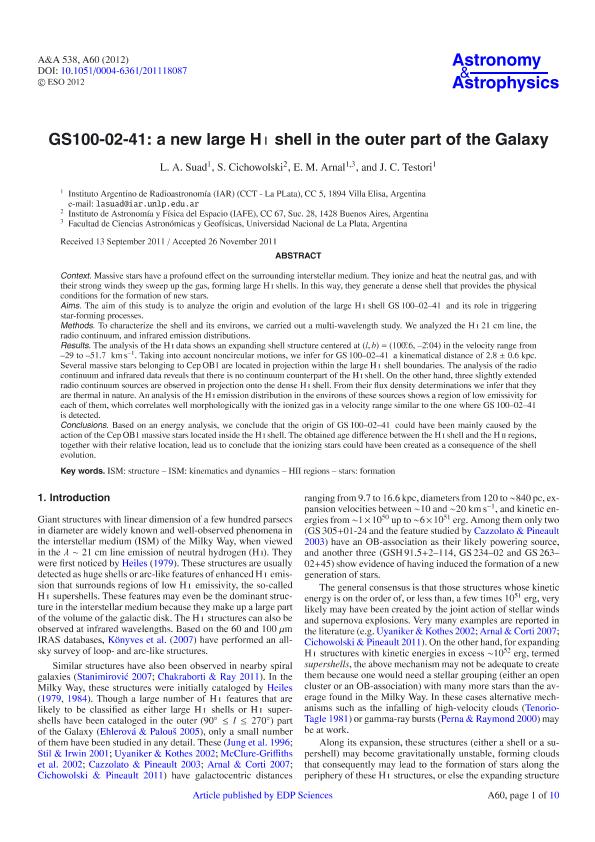Artículo
GS100-02-41: a new large H i shell in the outer part of the Galaxy
Fecha de publicación:
02/2012
Editorial:
EDP Sciences
Revista:
Astronomy and Astrophysics
ISSN:
0004-6361
Idioma:
Inglés
Tipo de recurso:
Artículo publicado
Clasificación temática:
Resumen
Context. Massive stars have a profound effect on the surrounding interstellar medium. They ionize and heat the neutral gas, and with their strong winds they sweep up the gas, forming large H i shells. In this way, they generate a dense shell that provides the physical conditions for the formation of new stars. Aims: The aim of this study is to analyze the origin and evolution of the large H i shell GS 100-02-41 and its role in triggering star-forming processes. Methods: To characterize the shell and its environs, we carried out a multi-wavelength study. We analyzed the H i 21 cm line, the radio continuum, and infrared emission distributions. Results: The analysis of the H i data shows an expanding shell structure centered at (l,b) = (100°.6, -2°.04) in the velocity range from -29 to -51.7 km s-1. Taking into account noncircular motions, we infer for GS 100-02-41 a kinematical distance of 2.8 ± 0.6 kpc. Several massive stars belonging to Cep OB1 are located in projection within the large H i shell boundaries. The analysis of the radio continuum and infrared data reveals that there is no continuum counterpart of the H i shell. On the other hand, three slightly extended radio continuum sources are observed in projection onto the dense H i shell. From their flux density determinations we infer that they are thermal in nature. An analysis of the H i emission distribution in the environs of these sources shows a region of low emissivity for each of them, which correlates well morphologically with the ionized gas in a velocity range similar to the one where GS 100-02-41 is detected. Conclusions: Based on an energy analysis, we conclude that the origin of GS 100-02-41 could have been mainly caused by the action of the Cep OB1 massive stars located inside the H i shell. The obtained age difference between the H i shell and the H ii regions, together with their relative location, lead us to conclude that the ionizing stars could have been created as a consequence of the shell evolution.
Palabras clave:
ISM: structure
,
ISM: kinematics and dynamics
,
HII regions
,
stars: formation
Archivos asociados
Licencia
Identificadores
Colecciones
Articulos(IAFE)
Articulos de INST.DE ASTRONOMIA Y FISICA DEL ESPACIO(I)
Articulos de INST.DE ASTRONOMIA Y FISICA DEL ESPACIO(I)
Articulos(IAR)
Articulos de INST.ARG.DE RADIOASTRONOMIA (I)
Articulos de INST.ARG.DE RADIOASTRONOMIA (I)
Citación
Suad, Laura Andrea; Cichowolski, Silvina; Arnal, Edmundo Marcelo; Testori, Juan Carlos; GS100-02-41: a new large H i shell in the outer part of the Galaxy; EDP Sciences; Astronomy and Astrophysics; 538; A60; 2-2012; 60-69
Compartir
Altmétricas




